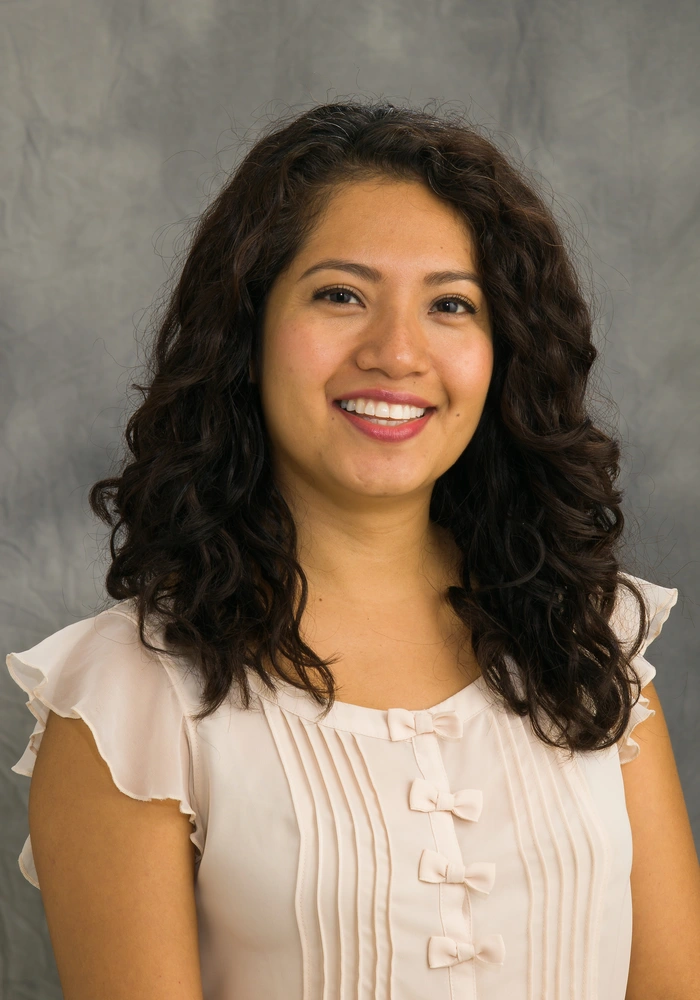
A magnet education program in a Los Angeles middle school offered Edzna Garcia her first opportunity to truly explore science, an experience that she says completely changed her education.
“I remember having so much fun dissecting various specimens and working on my first science project,” said Garcia, a graduate student in the Department of Chemistry. “These experiences encouraged me to enroll in a magnet high school where I took all the science classes I could possibly take. Tenth-grade chemistry became my favorite class, and it was then that I knew I wanted to pursue this field (chemistry).”
Garcia was born in Oaxaca, Mexico, the oldest of four children in her family and immigrated to the United States when she was seven years old.
Growing up in South Central Los Angeles, Garcia said she lived in a community where everyone looked like her for the most part, knew each other and took care of each other. She was taught to be helpful and learned everyone has something to contribute. Those values, she said, shape who she is today, someone who strongly believes in inclusivity and tries to support others.
Attending community college was the first time Garcia experienced feeling like an outsider.
“Sometimes I even felt unwelcomed, which was not a great feeling. I hope that I have never made anyone feel this way, and I always strive to be the best person that I can be to others,” said Garcia, explaining how transferring to a four-year university seemed almost unachievable at times.
Navigating the college world on her own was one of her biggest challenges as a first-generation college student.
“You are told that you can go to college to have a career, but no one tells you how to accomplish that,” she said. “I was so misguided every time I sought help or advice from academic counselors throughout my time at community college that I almost gave up on my dream to transfer to the University of California San Diego. Fortunately, I met the right academic counselor at the right time and look at where I am now.”
Garcia went on to earn a BS in pharmacological chemistry from UCSD, and a Master of Science in chemistry from California State University, Los Angeles, before beginning her path to a PhD at Illinois.
A sixth-year graduate student in organic chemistry in Steve Zimmerman’s research group, Garcia has been working on developing artificial enzymes based on polymers. The work led to the Zimmerman group being awarded a two-year creativity extension of funding from the National Science Foundation to develop a new class of sustainable degradable polymeric materials.
“Working in the Zimmerman lab and in this project has been very rewarding. It feels good to know that the research I have been working on with my other group members is being recognized,” she said.
In addition to research, Garcia has been involved in various student organizations, including the UIUC Chapter of the Society for Advancement of Chicanos/Hispanics and Native Americans in Science, serving as chapter vice president and president. She has also served as the SACNAS representative for the Student Wellness Coalition, as a peer mentor for the Sloan University Centers of Exemplary Mentoring and the Women Chemists Committee.
“I believe it is important to be involved, because it helps to create community. Community is beneficial for everyone but can be especially instrumental for underrepresented minorities,” Garcia said. “Finding a support system through friends in STEM who look like me was a challenge I faced as an undergraduate. I was often the only Latina in my science classes. Sometimes you just need a person that you can identify with to get through the hardships that come with a college experience, especially as a first-generation college student. I thought that it would be the same in graduate school, but fortunately I have met a few wonderful Latinx students in chemistry and other STEM fields through SACNAS.”
Inclusivity is important, Garcia said, because students from underrepresented groups should not feel isolated, or struggle to join a study group, or prove they belong, or try to “blend in” just to gain acceptance.
“Graduate school is stressful enough without these added barriers that students of color must face on a daily basis. Removing these barriers will help students of color be more successful. One can only dream that an increase in diversity will lead to acceptance,” she said.
Garcia was a nominee this year for the Women in Chemistry Inclusive Leadership Award. Her nominator wrote that Garcia "is one of the core members of the UIUC chemistry community who creates a welcoming space for people of color. She has displayed leadership in championing for diversity through her involvement with our SACNAS chapter, the WCC Mentoring Program, and the Student Wellness Coalition. She has actively recruited students of color at our recruitment weekends and follows up with them before and upon their arrival to UIUC, allowing students who may feel unsure or isolated to have a dependable mentor."
In the future, Garcia said she wants to work with underrepresented/underserved college students as a professor and mentor at a minority serving institution.
When she's not doing research in the lab, Garcia loves to spend some of her free time dancing.
“I joined a social ballroom dance RSO my second year at UIUC and loved it. I also got involved with the Latin dances and I have had the opportunity to teach beginner salsa and bachata,” she said.